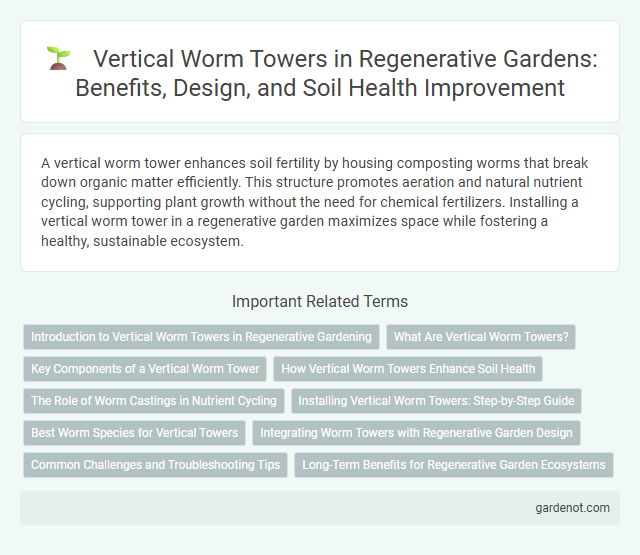A vertical worm tower enhances soil fertility by housing composting worms that break down organic matter efficiently. This structure promotes aeration and natural nutrient cycling, supporting plant growth without the need for chemical fertilizers. Installing a vertical worm tower in a regenerative garden maximizes space while fostering a healthy, sustainable ecosystem.
Introduction to Vertical Worm Towers in Regenerative Gardening
Vertical worm towers enhance soil fertility by creating deep, nutrient-rich channels that encourage beneficial earthworm activity in regenerative gardens. These towers increase organic matter breakdown and improve soil aeration, promoting healthier plant root systems and boosting overall garden productivity. Integrating vertical worm towers supports natural ecosystems and sustainable soil management practices essential for regenerative gardening success.
What Are Vertical Worm Towers?
Vertical worm towers are soil-enhancing structures that integrate vermiculture within garden beds, promoting efficient nutrient recycling and aeration. These towers consist of perforated PVC pipes filled with composting worms, which break down organic waste directly in the soil, enriching it with worm castings and beneficial microbes. By improving soil fertility and moisture retention, vertical worm towers support sustainable plant growth in regenerative gardening systems.
Key Components of a Vertical Worm Tower
A Vertical Worm Tower features key components such as a tall, perforated tube that provides ample space for worm habitation and nutrient exchange with surrounding soil. The base includes a mesh or breathable bottom to allow worm casting extraction while preventing pest infiltration. Its design supports continuous organic waste input at the top, facilitating efficient vermicomposting and seamless nutrient cycling within a regenerative garden ecosystem.
How Vertical Worm Towers Enhance Soil Health
Vertical worm towers improve soil health by promoting efficient organic matter breakdown and nutrient cycling directly within garden beds. Their deep structure allows worms to aerate the soil vertically, enhancing microbial activity and increasing soil fertility. This targeted vermicomposting boosts plant growth by creating a nutrient-rich environment with optimized moisture retention.
The Role of Worm Castings in Nutrient Cycling
Worm castings produced in vertical worm towers play a critical role in nutrient cycling by enriching the soil with essential minerals and beneficial microbes. These castings improve soil structure, enhance water retention, and increase nutrient availability for plant roots. The continuous breakdown of organic matter by worms accelerates nutrient release, promoting healthier and more productive regenerative gardens.
Installing Vertical Worm Towers: Step-by-Step Guide
Installing vertical worm towers involves selecting a well-drained site and digging a hole approximately 3 feet deep to accommodate the tower structure. Insert the worm tower firmly into the hole, ensuring the perforated sides are exposed to soil for optimum worm migration and nutrient exchange. Fill the tower with organic waste and cover it with soil to create a continuous composting environment that supports soil enrichment and plant growth.
Best Worm Species for Vertical Towers
The best worm species for vertical worm towers are red wigglers (Eisenia fetida) due to their efficiency in decomposing organic matter and thriving in confined environments. These worms excel at processing kitchen scraps and garden waste, accelerating nutrient cycling for healthy soil regeneration. Selecting Eisenia fetida maximizes compost quality and supports sustainable gardening practices within vertical worm towers.
Integrating Worm Towers with Regenerative Garden Design
Vertical worm towers enhance regenerative garden design by efficiently recycling organic waste into nutrient-rich compost directly within the soil profile. These towers promote soil aeration and microbial activity, creating a thriving environment for plant roots and improving water retention. Integrating worm towers supports sustainable nutrient cycling and reduces reliance on external fertilizers in regenerative gardening systems.
Common Challenges and Troubleshooting Tips
Vertical worm towers often face challenges such as poor aeration, leading to worm suffocation and slow decomposition, and excess moisture causing unpleasant odors and worm migration. To troubleshoot, ensure proper drainage by adding coarse materials like gravel at the base, and regularly monitor moisture levels to maintain damp but not waterlogged conditions. Introducing ventilation holes and turning the compost can improve airflow and encourage worm activity for optimal garden regeneration.
Long-Term Benefits for Regenerative Garden Ecosystems
Vertical worm towers enhance soil aeration and nutrient cycling by promoting continuous earthworm activity, which improves soil structure and fertility over time. These structures facilitate organic matter decomposition, increasing microbial diversity and boosting plant health in regenerative garden ecosystems. Consistent use of worm towers supports sustainable waste recycling, reducing the need for synthetic fertilizers and fostering resilient, self-sustaining soil environments.
Vertical worm tower Infographic

 gardenot.com
gardenot.com